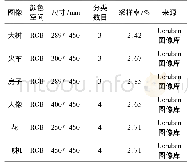《表4 CCNet性能:CCNet:面向多光谱图像的高速船只检测级联卷积神经网络(英文)》
 提示:宽带有限、当前游客访问压缩模式
提示:宽带有限、当前游客访问压缩模式
本系列图表出处文件名:随高清版一同展现
《CCNet:面向多光谱图像的高速船只检测级联卷积神经网络(英文)》
To demonstrate the efficiency of our CCNet,we compare it with the state-of-the-art deep-learning-based ship detection algorithm.The comparisons of the per-formances are listed in Table 6.Due to lack of evolution for small objects in previous works,we just compare the detection performance(Precision and recall)and detection speed.The precision and recall are evaluated under IOU 0.5 while Zhang et al[19].only provided under IOU0.4.The algorithms with multispectral image have higher performance than those algorithms with visible images.Our method owns the best precision compared with previous methods.Though the recall is less the Zhou et al.,the rate of scale variation of the largest ship and the smallest ship in our method is more than 20 times whereas only 4 times in the work by Zhou et al.[11].Thus,our CCNet is more robust than the method proposed by Zhou.As the ship occupy rate in our image dataset is far above the real remote sensing images,the FLOPS of our method is evaluated under the executive rate of REM and RDM is 5:1,which is also far above the real remote sensing images as the ship only occupies less 1%of the sea.Compared with the other methods,our method reduces the counts of FLOPS more than 5 times because the CCNet uses a cascaded model to extract ROIs and locate objects in ROIs.
| 图表编号 | XD0065890300 严禁用于非法目的 |
|---|---|
| 绘制时间 | 2019.06.01 |
| 作者 | 张忠星、李鸿龙、张广乾、朱文平、刘力源、刘剑、吴南健 |
| 绘制单位 | 中国科学院半导体研究所超晶格国家重点实验室、中国科学院大学材料与光电研究中心、中国科学院半导体研究所超晶格国家重点实验室、中国科学院大学材料与光电研究中心、中国科学院半导体研究所超晶格国家重点实验室、中国科学院大学材料与光电研究中心、中国科学院半导体研究所超晶格国家重点实验室、中国科学院大学材料与光电研究中心、中国科学院半导体研究所超晶格国家重点实验室、中国科学院大学材料与光电研究中心、中国科学院半导体研究所超晶格国家重点实验室、中国科学院大学材料与光电研究中心、中国科学院半导体研究所超晶格国家重点实验室 |
| 更多格式 | 高清、无水印(增值服务) |





